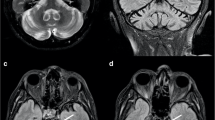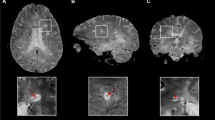Abstract
Purpose
Diagnosis of amyotrophic lateral sclerosis (ALS) can be difficult from clinical symptoms alone. Diffusion tensor imaging (DTI) has been suggested as an adjunct diagnostic method. DTI parameter changes have been repeatedly demonstrated, especially in the corticospinal tract (CST) as the predominantly affected structure. However, a recent meta-analysis reported only a modest discriminatory capability, questioning the value of this method as a confirmatory test in single subjects with suspected ALS. We investigated how methodological differences in CST delineation influence the discriminatory capability.
Methods
DTI data were acquired in 13 ALS patients and an age-matched healthy control group. We calculated and compared receiver operation characteristic (ROC) curves of four different analysis methods using either a manual or an atlas-based region of interest (ROI) of the CST in combination with and without tract-based spatial statistics (TBSS).
Results
The analysis method combining atlas-based ROIs with TBSS yielded an area under the curve (AUC) of 0.936 and a sensitivity and specificity of 100 % and 91.67 %. These are the best results among the four analysis methods evaluated: manual ROIs (AUC = 0.846, sensitivity: 69.23, specificity: 91.67), atlas-based ROIs alone (AUC = 0.917, sensitivity: 76.92, specificity: 91.67), manual ROIs in combination with TBSS (AUC = 0.885, sensitivity: 76.92, specificity: 91.67).
Conclusions
Sensitivity and specificity strongly depend on the CST delineation approach. The combination of an atlas-based ROI with TBSS is a promising fully automatic method with improved discriminatory capability compared to other approaches. It could ultimately serve as a confirmatory test in single ALS patients.


Similar content being viewed by others
References
Lee JR, Annegers JF, Appel SH. Prognosis of amyotrophic lateral sclerosis and the effect of referral selection. J Neurol Sci. 1995;132:207–15.
Turner MR, Scaber J, Goodfellow JA, et al. The diagnostic pathway and prognosis in bulbar-onset amyotrophic lateral sclerosis. J Neurol Sci. 2010;294:81–5.
Shoesmith CL, Findlater K, Rowe A, et al. Prognosis of amyotrophic lateral sclerosis with respiratory onset. J Neurol Neurosurg Psychiatr. 2007;78:629–31.
Millul A, Beghi E, Logroscino G, et al. Survival of patients with amyotrophic lateral sclerosis in a population-based registry. Neuroepidemiology. 2005;25:114–9.
Leigh PN. Amyotrophic lateral sclerosis. In: Eisen AA, Shaw PJ, editors. Motor neuron disorders and related diseases. Elsevier; 2007. p. 249–78.
Brooks BR, Miller RG, Swash M, et al. El Escorial revisited: revised criteria for the diagnosis of amyotrophic lateral sclerosis. Amyotroph Lateral Scler Other Motor Neuron Disord. 2000;1:293–9.
Filippi M, Agosta F, Abrahams S, et al. EFNS guidelines on the use of neuroimaging in the management of motor neuron diseases. Eur J Neurol. 2010;17:526–e20.
Agosta F, Chiò A, Cosottini M, et al. The present and the future of neuroimaging in amyotrophic lateral sclerosis. AJNR Am J Neuroradiol. 2010;31:1769–77.
Rossi M. Classical pathology. In: Eisen AA, Shaw PJ, editors. Motor neuron disease. London: Chapman & Hall Medical; 1994. p. 307–41.
Ince PG, Wharton SB. Cytopathology of the motor neuron. In: Eisen AA, Shaw PJ, editors. Motor neuron disorders and related diseases. Elsevier; 2007. p. 249–78.
Foerster BR, Dwamena BA, Petrou M, et al. (2012) Diagnostic accuracy using diffusion tensor imaging in the diagnosis of ALS: a meta-analysis. Acad Radiol. 2012. http://www.ncbi.nlm.nih.gov/pubmed/22749050. Accessed 1 Aug 2012.
Wakana S, Caprihan A, Panzenboeck MM, et al. Reproducibility of quantitative tractography methods applied to cerebral white matter. Neuroimage. 2007;36:630–44.
Hua K, Zhang J, Wakana S, et al. Tract probability maps in stereotaxic spaces: analyses of white matter anatomy and tract-specific quantification. Neuroimage. 2008;39:336–47.
Rorden C, Brett M. Stereotaxic display of brain lesions. Behav Neurol. 2000;12:191–200.
Woolrich MW, Jbabdi S, Patenaude B, et al. Bayesian analysis of neuroimaging data in FSL. Neuroimage. 2009;45:S173–86.
Smith SM, Jenkinson M, Woolrich MW, et al. Advances in functional and structural MR image analysis and implementation as FSL. Neuroimage. 2004;23 Suppl 1:S208–19.
Smith SM. Fast robust automated brain extraction. Hum Brain Mapp. 2002;17:143–55.
Rueckert D, Sonoda LI, Hayes C, et al. Nonrigid registration using free-form deformations: application to breast MR images. IEEE Trans Med Imaging. 1999;18:712–21.
Turner MR, Agosta F, Bede P, et al. Neuroimaging in amyotrophic lateral sclerosis. Biomark Med. 2012;6:319–37.
Easterbrook PJ, Berlin JA, Gopalan R, et al. Publication bias in clinical research. Lancet. 1991;337:867–72.
Vollmar C, O’Muircheartaigh J, Barker GJ, et al. Identical, but not the same: intra-site and inter-site reproducibility of fractional anisotropy measures on two 3.0 T scanners. Neuroimage. 2010;51:1384–94.
Fox RJ, Sakaie K, Lee J-C, et al. A validation study of multicenter diffusion tensor imaging: reliability of fractional anisotropy and diffusivity values. AJNR Am J Neuroradiol. 2012;33:695–700.
Pagani E, Hirsch JG, Pouwels PJW, et al. Intercenter differences in diffusion tensor MRI acquisition. J Magn Reson Imaging. 2010;31:1458–68.
Acknowledgments
We would like to thank all patients and healthy subjects who participated in our study. We are especially grateful to the staff of the Charité ALS outpatient department for their valuable support. S. Hirsch and I. Sack are supported by the German Research Foundation grants Sa-901/7 and Sa-901/10. Mr. Scheel is supported by the “Friedrich C. Luft” Clinical Scientist Pilot Program funded by Volkswagen Foundation and Charité Foundation.
Conflict of interest
The authors declare that they have no conflict of interest.
Author information
Authors and Affiliations
Corresponding author
Electronic supplementary material
Rights and permissions
About this article
Cite this article
Prokscha, T., Guo, J., Hirsch, S. et al. Diffusion Tensor Imaging in Amyotrophic Lateral Sclerosis—Increased Sensitivity with Optimized Region-of-Interest Delineation . Clin Neuroradiol 24, 37–42 (2014). https://doi.org/10.1007/s00062-013-0221-2
Received:
Accepted:
Published:
Issue Date:
DOI: https://doi.org/10.1007/s00062-013-0221-2




